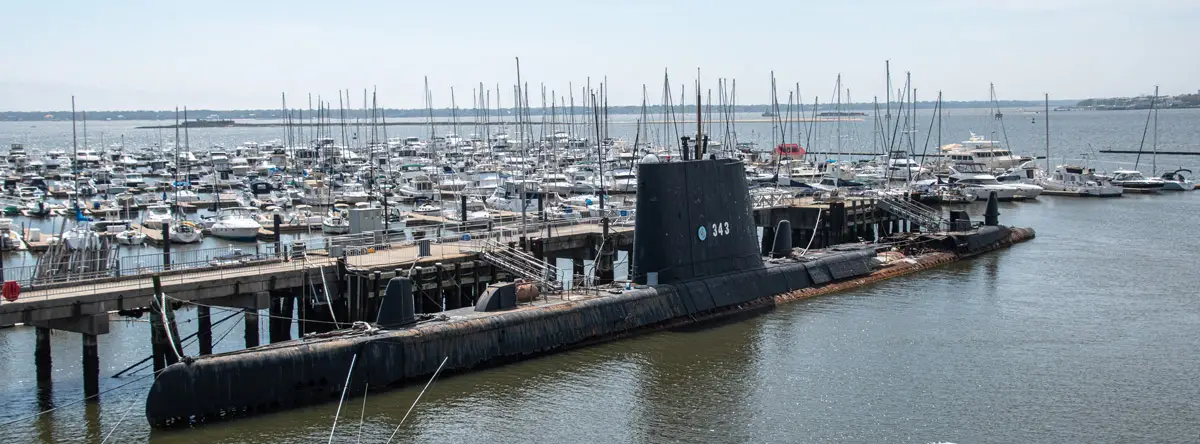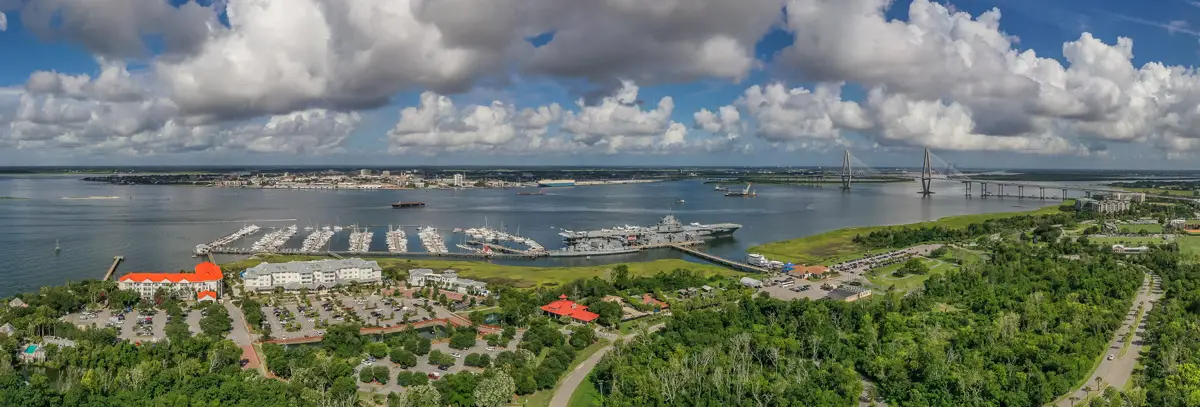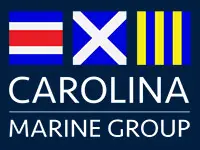The 322-foot Cold War-era submarine, USS Clamagore (SS 343), was decommissioned in 1975 after thirty years of service and has been docked at Patriot’s Point Naval & Maritime Museum, in Mount Pleasant, SC as a military attraction since 1979. It was the only submarine of its design that was preserved in the US. Clamagore was listed on the National Register of Historic Places and was designated a National Historic Landmark on June 29, 1989
In December 2021, after springing a leak in the main ballast tank, it was closed to the public. While many people wanted it to remain a floating museum, and others wanted it to be sunk off the coast of Florida to become an underwater museum and playground for fish and scuba divers, it was instead scheduled to be pulled slowly across 475 miles of coastal waters away from Patriots Point and taken to Norfolk, VA where she will be recycled. The fact that it needed extensive repairs and an expensive restoration after years in the water resulted in the decision to scrap the vessel, since maintaining it was unsustainable. The cost to dry-dock and repair it was estimated at $10 million.

Subsequently, following the decision to recycle the USS Clamagore, crews worked to remove materials and improve buoyancy on the submarine to affect the move that took place in the fall of 2022. The current $2 million operation included the removal of 504 batteries, each weighing 900 pounds as well as an extensive number of fittings and internals from the vessel, all in an effort to raise her hull as much as possible for her last ride.
The twice modified Guppy-class sub, USS Clamagore, was a surveillance boat stationed in Key West, Florida, during the Cold War, when it was known as the “Grey Ghost of the Florida Coast,” being a Soviet submarine tracker. The second and last time, it was modified to become one of nine subs having the top upgrade for diesel-powered submarines. The diesel-powered Clamagore was still in training when World War II ended. It was finally commissioned on June 28, 1945 to patrol the Caribbean and North Atlantic. As a National Historic Landmark, she was the last surviving example of a submarine with the Balao-class GUPPY III upgrade (1946-1960). The Greater Underwater Propulsion Power Program (GUPPY) improved the submerged speed, maneuverability, battery capacity and overall performance of the nine chosen submarines, including the Clamagore.
The Balao class was one of the Navy’s successful designs and the largest class of submarines in the United States Navy used during World War II with 120 boats completed and housing 80 men at one time with only 2 toilets. The most significant improvement was the use of thicker, higher yield strength steel in the pressure hull skins and frames, which increased their test depth to 400 feet. They were true diesel-electric submarines. Of the Balao-class fleet, the Clamagore survived the longest.

The Clamagore operated off Key West with various fleet units and with the Fleet Sonar School, voyaging occasionally to Cuba and the Virgin Islands until she entered the Philadelphia Naval Shipyard for modernization and installation of snorkel. (A submarine snorkel is a device which allows a submarine to operate submerged while still taking in air from above the surface, referred to as the snort.) She took part in NATO exercises in the North Atlantic, before arriving at Charleston, SC her new home port.
The Clamagore joined the 6th Fleet in the Mediterranean for a brief tour of duty after which the submarine returned to Charleston. In 1962, Clamagore underwent the GUPPY III conversion which added 15 feet (4.6 m) to her hull, a plastic sail and the PUFFS passive ranging sonar, which included the three sharkfin sensors on her deck. After finishing her GUPPY III conversion, she was transferred to New London. Finally, after 30 years of service, the Clamagore was donated as a museum ship to the Patriot’s Point Naval & Maritime Museum, in Mount Pleasant, SC on 6 August 1979, to be viewed alongside aircraft carrier Yorktown and destroyer Laffey.

INTERESTING TO NOTE:
The Clamagore was the Navy's first submarine named after the blue parrot-fish found on coral reefs in the shallow waters of the West Indies and Chesapeake Bay. In 1819, Congress formally placed the responsibility of naming US vessels in the hands of the Secretary of the Navy, a practice which still exists today. For some thirty years, from the 1920s to the 1950s, American submarines were consistently named after fish. Since most WWII submarines were already named after fish, it left the naming practice fairly intact with a few exceptions over the years.
While the naming of subs did not have any fixed rules, they were generally given names of fish and land creatures that stung. Although the naming of submarines after fish was followed until the 1950s, even in the 1970s, attack submarines were still continuing the tradition of being named for sea creatures, with a few exceptions. The naming of a ship is done before the ship is christened. Until the christening ceremony, she (the ship or sub) is referred to as PCU (pre-commissioned unit) along with what will be her name. Once christened, she becomes an official USS ship.
The use of fish names became a problem for the Navy since the Ichthyologists (Fish Scientists) used Latin names. Many times, a name easier to pronounce was assigned to fish for the Navy to use for a submarine. The Navy was concerned that if a sailor’s wife or girlfriend could not spell the name of the fish, the sailors would not receive their mail. The Smithsonian would often send information and pictures of the fish for which a sub was named to the ship’s captain, which would then be hung onboard for sailors to take pride in their ship’s namesake.
The U.S. Navy had 66 submarines of various types in active service, with 18 more in reserve as of December 2018. The fleet consists of nuclear-powered fleet submarines (SSBNs) and attack submarines (SSNs), as well as diesel-electric submarines (SSDs) in the reserve fleet. The US had the first documented used of submarines in combat.
USS CLAMAGORE STATS 1962:
Built by: Electric Boat Co. in Groton, Connecticut
Weight: 1,975 tons
Length: 322 ft 5 in (98 meters)
Speed: 17.2 knots on surface; 14.5 knots submerged (30 minutes)
Range: 15,900 nm (29,400 km) at 8.5 knots (15.7 km/h) on surface
Armament: 10X21 in (533 mm) torpedo tubes, (6 forward, 4 aft), 24 torpedoes
The farewell ceremony for the USS Clamagore was held at Patriots Point before the sub known as “the Grey Ghost of the Florida Coast” was moved to Norfolk, Virginia for recycling. The ceremony was not be open to the public. There was an extensive list of parts and pieces that are being held on to from the Clamagore to put on display in the USS Yorktown and other museums across the country with the hope of keeping the memory of this Historic Landmark alive.
